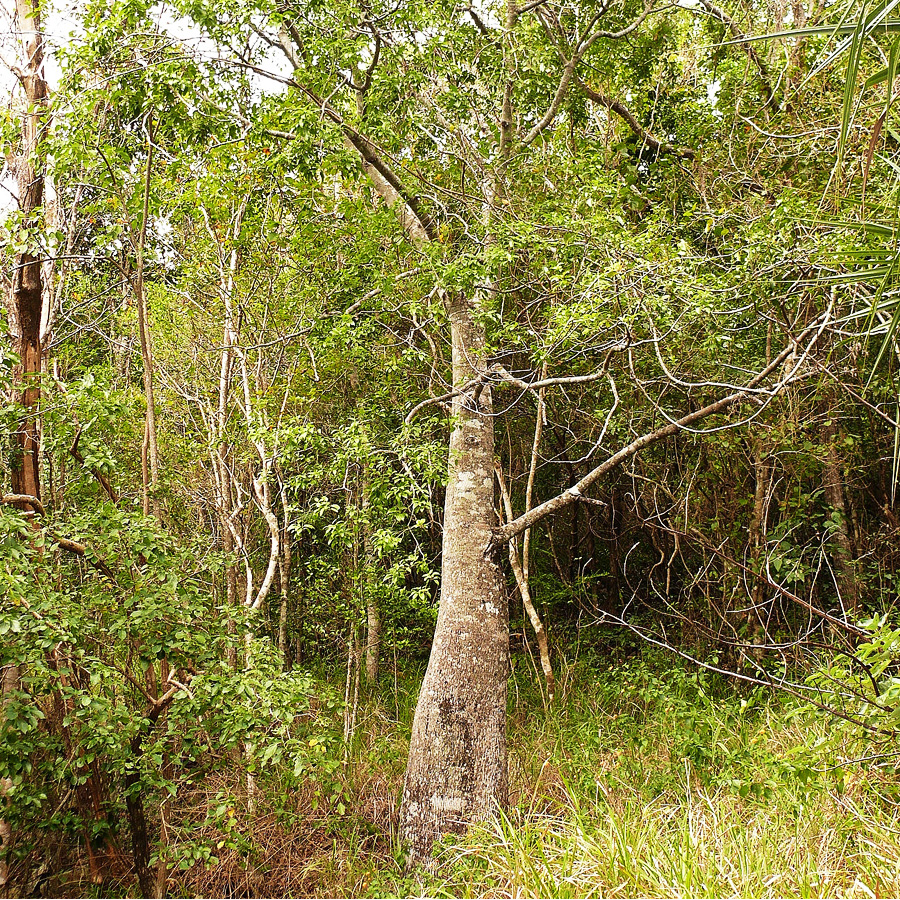Whitsunday Bottle Tree
Brachychiton compactus
Conservation Status:
Queensland State: Not Listed
Species and status overview
The Whitsunday bottle tree is found only within the catchments that drain into Pioneer Bay and the Airlie Beach area, and offshore islands including Hook, Armit and Double Cone islands. This very limited distribution puts the species under threat from urban and rural residual expansion.
The species presence, preferred soil type, aspect and plant species which commonly accompany the tree were studied in 2007 by Whitsunday Regional Council through a grant provided by Reef Catchments (then Mackay Whitsunday Natural Resource Management Group) from the Natural Heritage Trust. The study showed the primary limiting factors for the distribution of the Whitsunday bottle tree habitat were a preference for
a) sites that drain into Pioneer Bay
b) sites with an average annual rainfall greater than 1400mm
c) sites that are moderately well to very well drained (they are not found on flat, clayey alluvial soils)
The rounded base of the trunk of the Whitsunday bottle tree, whilst giving rise to it’s name can also be taken quite literally: they do indeed store a significant amount of water between the inner bark and the trunk. A tree’s insurance policy for dry times.
Description
The Whitsunday bottle tree can grow to a height of 12 m however, most coastal trees will only reach between 4 and 8 m. The thick, bottle shaped trunk can be greater than 2 m in diameter and supports a round, compact, dark green canopy.
Leaves of adult trees differ significantly from those of juvenile specimens. Adult leaves are shiny green above and paler below, 6-12 cm long and 2.5 – 5.5 cm wide and have a ‘typical’ leaf form. Juvenile leaves look more like a hand with long (6-13 cm), skinny (1–3.2 cm wide) fingers joined at the centre where they meet the leaf stalk petiole.
The 5-8 mm long by 14-17 mm wide pretty, white flowers have pink centre inside each of the five petals. Boat shaped seed pods are around 5-9 cm in length and 2-4 cm in diameter and contain numerous seeds.
The Whitsunday bottle tree is found in rocky rainforests in the Whitsundays usually on the lower slopes of hills and occasionally on rocky headlands on well drained soil.
Conservation concerns
The original extent of the preferred habitat of the Whitsunday bottle tree has been estimated to be 8175 ha on the mainland. Of this it is estimated that 300 ha have been destroyed or modified for development. A further 680 ha of the remaining 7875 ha is also threatened by future development (at 2007).
Threats include
- Clearing for urban expansion and development
What can I do?
- Consider retaining Whitsunday bottle trees as a landscaping feature in development activities
- Plant a Whitsunday bottle tree in your garden. Visit Whitsunday Catchment Landcare to find out where and when you can obtain this species
More Information
Photographs Brachychiton compactus Airlie Beach bottle shaped trunk, Brachychiton compactus Airlie Beach open seed capsule, Brachychiton compactus Airlie Beach, Brachychiton compactus Airlie Beach, Brachychiton compactus Airlie Beach trees of the same species vary depending on location, Brachychiton compactus Airlie Beach unripe pods, Brachychiton compactus juvenile leaves, Brachychiton compactus pod and leaves
